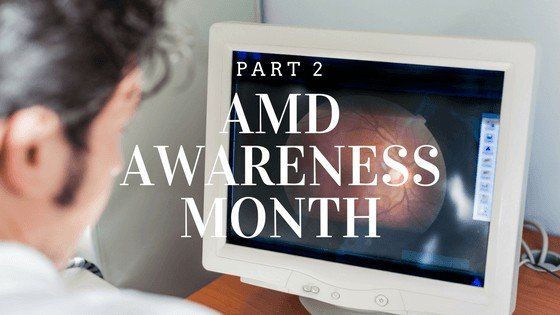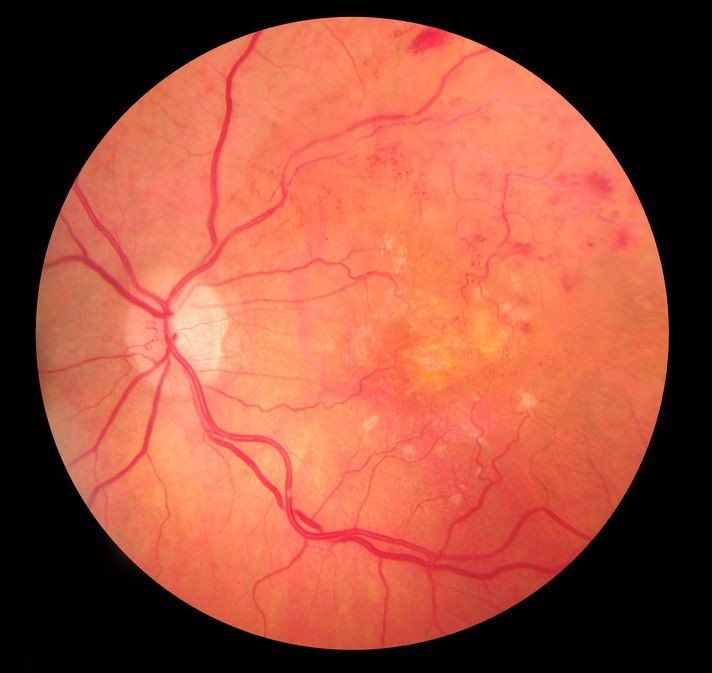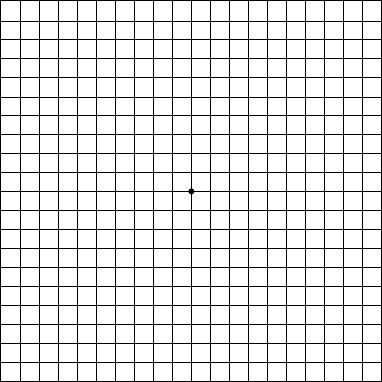Do You Know Your Treatment Options For AMD?
This week on the Eye-Q blog we are continuing on with the theme of AMD Awareness. If you missed our last post that covered exactly what AMD is - be sure to check it out here . Now let’s jump right in with some common symptoms.
What Are The Symptoms Of AMD?
As with other eye diseases, such as Glaucoma , macular degeneration in its early stages often has no symptoms that would alert you to a problem until your vision becomes damaged. However, there are some early signs - such as the presence of protein deposits called drusen - that your eye doctor will be able to catch at your yearly eye health exam. For this reason, it is incredibly important to make seeing your optometrist or ophthalmologist a priority - even if you don’t feel like your vision has changed.
As the disease starts to progress, there are a number of symptoms you might experience that will differ in severity depending on how advanced your AMD is.
DRY AMD SYMPTOMS
- Hazy or blurry vision
- Difficulty recognizing people’s faces
- Colors appearing less vivid
- A dark or blurry spot in your central vision
- Trouble switching from bright light to low light and vice versa
- Increase in need for bright light to see up close
WET AMD SYMPTOMS
- Loss of central vision
- Size of objects or colors appearing different for each eye
- Colors appearing less vivid
- Blank spots or dark spots in vision
- Straight lines appearing bent, crooked, or otherwise distorted
Dry AMD can present in one or both eyes, and you may not even notice vision changes if only one eye is affected since your unaffected eye will compensate for any vision loss in the other eye. Conversely, wet AMD symptoms will be more noticeable and can worsen quickly.
How Is AMD Diagnosed?
Luckily, diagnosing macular degeneration is pretty straight forward. Your eye doctor will be able to detect any signs of the disease by performing a dilated eye examination and using an instrument called an ophthalmoscope to view your retinas. The ophthalmoscope is a handheld device that allows the viewing of interior structures of the eye with the help of a light source and built-in lenses.
Other helpful diagnostic tools are fundus photography - which captures a high resolution photograph of the interior structures of the eyes - and optical coherence tomography (OCT). An OCT uses light rays to take cross sectional images of your retina and allows each of its individual layers to be seen and measured showing any signs of abnormal blood vessels, holes, tears, or degeneration.
If your doctor suspects wet macular degeneration, you may need to see a retinal specialist for a diagnostic procedure called fluorescein angiography. This is where a dye is injected into a vein in your arm, and as the dye travels throughout the body photographs are taken of your eye. Any abnormal areas will be highlighted by this dye allowing the doctor to assess whether wet macular degeneration treatment is possible and where it is needed.
Your doctor will also likely send you home with an amsler grid to help monitor your vision for any changes. Get a free printable Amsler Grid with instructions on how to perform the test at home.
Treating Dry AMD
Since there is not currently a cure for AMD, preventative methods are your best bet when it comes to preserving your vision. Furthermore, there is no treatment available for dry AMD. This means staying on top of your eye health and ensuring that if you have dry macular degeneration you are diligent in your attempts to keep it from turning into the more aggressive wet form is of crucial importance. While there are some risk factors for AMD that are out of your control such as gender, age, and family history - there are other things you can control like quitting smoking and leading an overall more healthy lifestyle.
According to The Age-Related Eye Disease Study 2 (AREDS2), taking a dietary supplement containing vitamin C, E, lutein, zinc, and zeaxanthin lowered the risk for macular degeneration progression by at least 25 percent. Other studies have shown that eating a diet rich in brightly colored fruits and vegetables as well as dark leafy greens may reduce your risk for developing macular degeneration altogether.
Of course, you should be sure to check with your doctor before beginning any supplement routines.
Treating Wet AMD
If you have wet macular degeneration, the goal of treatment is typically geared towards stopping or slowing the growth of abnormal vessels and their subsequent leakage. This can be done a few different ways.
ANTI-VEGF TREATMENTS
Remember when we talked about what wet macular degeneration was in our last post and we mentioned the VEGF response? One of the most commonly utilized treatments involves targeting your body’s vascular endothelial growth factor (VEGF). Anti-VEGF medications work by blocking the VEGF response and reducing the growth of abnormal blood vessels. This in turn helps avoid further sight loss by reducing the risk of scarring and damage that these new vessels cause.
These medications are administered as injections with a very fine needle through your sclera (white of your eye) and directly into the vitreous (jelly like substance inside of the eye). This can sound scary, however, the injections are quick, and a numbing drop is usually administered beforehand so that you do not feel pain.
In some instances, you may have to receive anti-VEGF injections in combination with other treatments. This will all depend on how aggressive your macular degeneration is.
LASER TREATMENTS
AMD can also be treated with the help of a focused high-energy beam of light. This laser destroys abnormal blood vessels by essentially burning them away to prevent further leakage, growth, and damage. The abnormal blood vessels as usually completely destroyed by this process. However, in around 50 percent of patients with wet macular degeneration, re-treatment will be needed within 3 to 5 years as new blood vessels grow in other areas. This is why laser treatment is sometimes paired with anti-VEGF treatments.
COOL LASER THERAPY
Another treatment option for wet AMD is called photodynamic therapy (PDT). With this method, a light-activated drug called a photosensitizer is used in combination with a low-power laser (aka cool laser). The photosensitizer is injected into a vein in the arm where it travels throughout the body - including into the abnormal vessels behind the macula. The laser is then focused directly on the unwanted vessels, activating the drug and destroying only those vessels targeted. As with the previously mentioned laser therapy, multiple treatments may be needed.
If you have advanced vision loss from AMD, learn how to make the best of your remaining vision by learning new strategies to accomplish daily activities with the help of low vision aids. Visit the American Academy of Ophthalmology for more information.
Stay tuned for our final AMD blog post where we will wrap up AMD Awareness Month with a few tips for prevention and some surprising facts and statistics.






